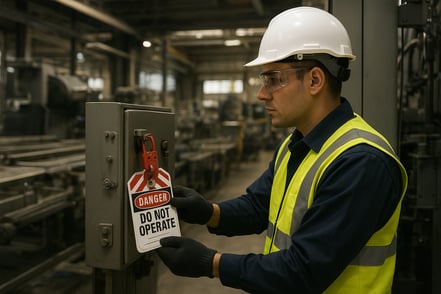The Case for Change: Why SOPs and Slide Decks No Longer Cut It
Industrial operators—from oil & gas to renewables to utilities—are under mounting pressure to do more with less. Aging workforces are retiring, compliance standards are tightening, and operational complexity is increasing. Traditional training methods are struggling to keep up.
SOP manuals, while essential, are static by nature. They lack context, interactivity, and site specificity. Classroom sessions offer limited engagement and little retention. And shadowing can be inconsistent, unsafe, and difficult to scale—especially across distributed workforces or remote job sites.
Enter VR industrial training: a solution that combines experiential learning, site realism, and repeatability in a way that drives real-world impact.
What Industrial VR Training Looks Like in Practice
At its core, VR industrial training replicates real procedures in simulated environments—allowing workers to build muscle memory, respond to emergencies, and master complex tasks without stepping foot in a live facility.
Common use cases include:
- Confined space entry and hazard identification
- Lockout/Tagout (LOTO) procedures
- Emergency response to fires, leaks, or shutdown events
- Routine maintenance and inspection of site-specific equipment
- Site inductions and orientation for contractors or new hires
With no-code VR platforms like Facilitate, these simulations are now faster and easier to create than ever. L&D teams and subject matter experts can build and update content internally—without needing developers or third-party vendors.
Quantifying the ROI: Downtime, Incidents, and Onboarding
The true power of VR training lies in the return on investment (ROI)—both in human safety and business performance.
- Reduced Downtime
When operators are trained in realistic, repeatable simulations, they’re more confident and less error-prone. This reduces costly mistakes and equipment misuse that can bring operations to a halt. According to PwC, VR-trained employees complete tasks up to 4x faster than classroom learners. - Fewer Incidents
VR allows for safe exposure to hazardous scenarios—fires, pressure buildups, electrical faults—so workers know how to respond before it happens for real. Shell reported a 45% reduction in safety incidents after introducing VR training at scale. - Accelerated Onboarding
VR compresses the time needed to onboard new workers, especially in technically demanding or unionized environments. Instead of relying on limited trainers or job shadowing, companies can deploy standardized simulations that upskill employees faster—and with greater consistency. One Facilitate client in the energy sector cut onboarding time by 30%, without compromising safety or quality.
From the Field: A Practical Example
In one implementation, a U.S. utility company used Facilitate’s platform to replace outdated training modules for substation maintenance and pole-top rescue drills. Their L&D team created customized simulations using real 360° site imagery and voiceover guidance—all in-house.
The result? More than 90% of trainees reported higher confidence in their roles. Supervisors noted fewer procedural errors during field audits, and the company avoided $150,000 in potential downtime from one near-miss that was prevented through simulated emergency training.
Why No-Code Changes the Game
Historically, creating industrial VR training required external developers, long timelines, and high upfront costs. This made it accessible only to large enterprises with deep pockets.
Today, no-code VR platforms like Facilitate are democratizing access. Anyone can build and update immersive content using a simple drag-and-drop interface—combining 360° video, assessments, and even voiceovers or 3D models. This reduces dependency on external vendors and empowers companies to respond quickly when processes or safety protocols change.
Plus, with integrations into SCORM-compatible LMSs and xAPI support, training outcomes are easily trackable—making it easier for safety, compliance, and L&D teams to demonstrate value.
Getting Started: What You Need
To begin transforming your training with VR, you don’t need a big budget or a dev team. You need:
- A training objective (e.g., safety procedure, equipment task, emergency response)
- Some 360° media from your site or assets
- A team of SMEs or trainers to guide the content
- A no-code platform like Facilitate
From there, you can rapidly create and scale VR content across job sites, regions, or departments.
To learn more, explore Facilitate’s Implementation Package FAQs or review our Energy Sector Use Cases to see examples of what’s possible.
Conclusion: The Future of Industrial Training Is Experiential, Scalable, and ROI-Driven
From boiler rooms to control rooms, the demands on industrial workers are only increasing. Training must evolve to keep pace—with tools that are engaging, effective, and ready for deployment at scale.
VR industrial training isn’t just a nice-to-have. It’s a competitive advantage.
And thanks to platforms like Facilitate, it’s never been easier—or more affordable—to bring that advantage to your organization.
Curious how Facilitate can transform your training? Contact us today to explore a tailored demo and see the ROI of no-code immersive learning for your team.





Comments